TRUSI is a highly informative a method for diagnosing diseases of the genitourinary system as in menand in women. For the study to be comfortable and safe, you need to carefully prepare for it.
Record content:
- 1 What is TRUZI?
- 2 Differences between TRUS and ultrasound
- 3 What is the transrectal method used for?
- 4 Indications for the study
- 5 Indirect indications
- 6 Contraindications
-
7 Preparation for TRUS
- 7.1 Bladder
- 7.2 Intestines
- 7.3 Food
- 7.4 Special drugs
- 8 Conducting TRUS of the prostate, bladder in men
- 9 What does the doctor see during the study?
- 10 Feelings of the patient
- 11 Decoding the results
- 12 What diseases can be diagnosed using the method?
- 13 Video about TRUS
What is TRUZI?
TRUS (stands for transrectal ultrasound) is an instrumental method of examining the organs of the pelvic region. It is carried out by introducing an ultrasound probe into the rectum and is most often used to examine the organs of the genitourinary system of men.
Less often, it is assigned to young girls who are not sexually active (with menstrual irregularities or painful periods). Through the rectum, the doctor examines the uterus, ovaries and appendages.
Differences between TRUS and ultrasound
TRUSI (preparation for the study begins 2-3 days before it) refers to the types of ultrasound. But due to the introduction of the device sensor into the rectum, this method has a higher level of information content, since it allows you to accurately determine the structure and size of the prostate. Also, thanks to better visualization, the doctor can see neoplasms and other pathologies.
Conventional ultrasound cannot give a complete picture of the organ, since the prostate is located behind the bladder and rectum. Therefore, in the absence of contraindications, it is a transrectal study that is recommended.
What is the transrectal method used for?
The transrectal method is used to:
- assessing the size and structure of prostate tissues: its density, homogeneity, the presence of uncharacteristic formations;
- studying the structure of the tissues of the testicles, their appendages and the spermatic cord;
- assessing the state of the urethra;
- diagnosing benign and malignant neoplasms of the prostate gland;
- identifying prostatitis;
- diagnosing cysts in the tissues of the prostate gland and testicles;
- diagnosing inflammatory diseases and vascular disorders of the testicles and epididymis;
- identification of stricture (narrowing of the lumen) of the urethra;
- determining the causes of male infertility;
- evaluating the results of treatment.
In the case of TRUS in girls who are not sexually active, it is possible to assess the structure and condition of the uterus, ovaries and appendages - deviations can be the reason for irregular or absent menstruation, too painful menstruation, heavy bleeding, and others pathologies.
Indications for the study
TRUS (preparation for the study must be agreed with the doctor) must be prescribed for chronic prostatitis (if there are no contraindications) in order to track the dynamics of the disease and evaluate the results of the therapy.
Also, an examination is prescribed if the patient has an increased level of prostatic specific antigen - a tumor marker, or if, during a finger examination of an organ, the doctor found a seal, and the patient feels soreness.
Men over the age of 45 are recommended to undergo TRUS once a year for preventive purposes, since the risk of neoplasms in this category of men is significantly higher than in young men.
Also, the regular passage of TRUS is indicated for men with the following indications:
- increased risk of developing benign and malignant neoplasms of the prostate;
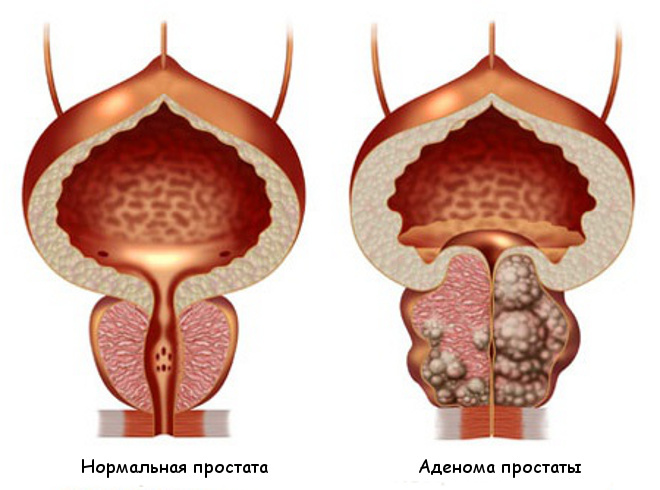
- genetic predisposition to prostate diseases;
- endocrine system diseases;
- severe physical inactivity, sedentary lifestyle.
Regular examination will help identify pathologies of the genitourinary system in the early stages and begin timely treatment.
Indirect indications
TRUS can also be prescribed for indirect indications when there are suspicions of any diseases of the male genitourinary system.
It is prescribed for:
- violations of urination (incontinence or urinary retention, weak pressure or intermittent stream);
- signs of "residual urine" (if, after going to the toilet, you feel the urge to urinate again, which does not end with the release of urine);
- pain during urination;
- the presence of purulent discharge or blood in the urine;
- uncharacteristic discharge from the urethra;
- erectile dysfunction, premature ejaculation (which did not exist before), weakening of potency;

- pain in the lower abdomen and groin area, not associated with physical activity (possibly worsening during intercourse);
- a feeling of heaviness and pain in the rectum;
- pain in the lumbar region, not associated with diseases of the spine and nearby muscles;
- deviations from the norm of special results of blood and urine tests;
- unsatisfactory attempts at conception during the last 6 months.
Also, TRUS is prescribed before surgery to exclude some contraindications. If there is a suspicion of the presence of neoplasms, then during the TRUS process, a biopsy can be performed and tissue of the prostate gland is taken for subsequent microscopic examination.
Contraindications
Transrectal examination cannot be performed with:
- exacerbation of the chronic form of prostatitis;
- the presence of a pararectal fistula;
- bleeding from the anus of any nature (including unexplained etiology);
- the presence of hemorrhoids, cracks in the anus;
- inflammatory pathologies of the rectum in the acute stage;
- diarrhea;
- obstruction of the rectum;
- recent surgery on the rectum or prostate gland;
- the removed part of the rectum;
- too agitated or hysterical state of the patient;
- mental illness.
Preparation for TRUS
TRUS of the prostate gland requires preliminary preparation, which will help not to distort the results of the study.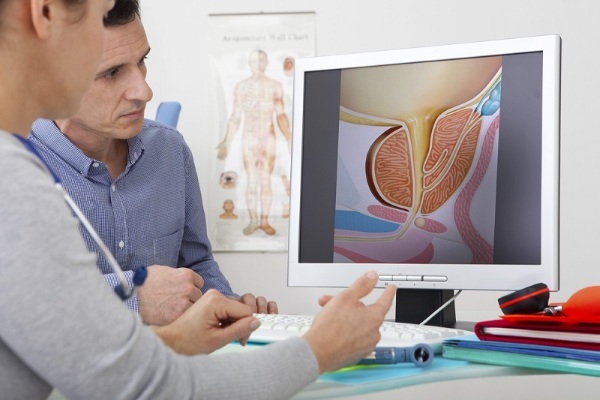 If you do not follow any rule, then the patient can be sent to the doctor for a second procedure. In the worst case, due to the distortion of the results, the man can be misdiagnosed and prescribed inappropriate therapy.
If you do not follow any rule, then the patient can be sent to the doctor for a second procedure. In the worst case, due to the distortion of the results, the man can be misdiagnosed and prescribed inappropriate therapy.
Bladder
During the procedure, the bladder must be completely filled - the organs behind it are visible through the full bladder.
If the organ is not full enough, it will shrink, which can affect the effectiveness of the diagnosis.
For 1.5-2 hours before the procedure, you need to go to the toilet, and then gradually (at some intervals) drink 5-6 glasses normal water and during this time do not empty the bladder until the doctor who performs diagnostics.
Intestines
TRUSI (preparation for the study begins in 2-3 days) involves preliminary cleaning of the rectum in order to make the procedure as hygienic as possible and to avoid unexpected bowel movements.
Cleansing is carried out in the evening on the eve of TRUS and in the morning before the procedure. For this, you can use laxatives ("Fitolax", "Duphalac"), but it is better to use microclysters (for example, "Microlax"), as they act faster and more efficiently.

You can also cleanse the rectum with the help of rectal suppositories with glycerin, which stimulate bowel movements. During the introduction, the patient should lie on his side so that the contents of the drug do not leak out, and when the urge to defecate appears, immediately visit the toilet.
Food
Excessive gassing can also distort the results.
To eliminate this problem 2-3 days before the procedure, the following products must be excluded from the diet:
- cabbage;
- legumes (lentils, peas, beans, beans);
- asparagus;
- fruits and berries;
- raw, salted and pickled vegetables (allowed in small quantities baked or boiled);
- carbonated drinks, alcohol, tea and coffee;
- juices;
- milk and dairy products;
- fresh wheat bread;
- soups with strong meat broth;
- pastries and sweets.
If there is a tendency to increased gas formation, then during the preparation period it is recommended to drink special drugs that help eliminate gases in the intestines: "Espumisan", "Simethicone with fennel ”. You can also drink tea with fennel, as this plant improves digestion and helps to eliminate excess gas in the intestines.
Dinner on the eve of the procedure should be easily digestible - it can be baked fish with vegetables, vegetable casserole, light soup. The last meal should be 8-12 hours before. before the procedure - you need to come to it hungry.
Special drugs
If the patient is taking drugs that affect blood clotting (anticoagulants or antiplatelet agents), then 2-3 days before TRUS, you need to stop taking them in order to avoid complications on the rectum. Before you stop taking it, be sure to consult with your doctor.
Conducting TRUS of the prostate, bladder in men
TRUSI (preparation for the study will help to avoid side effects from the procedure) does not require anesthesia and the use of any such means, as it is a painless method.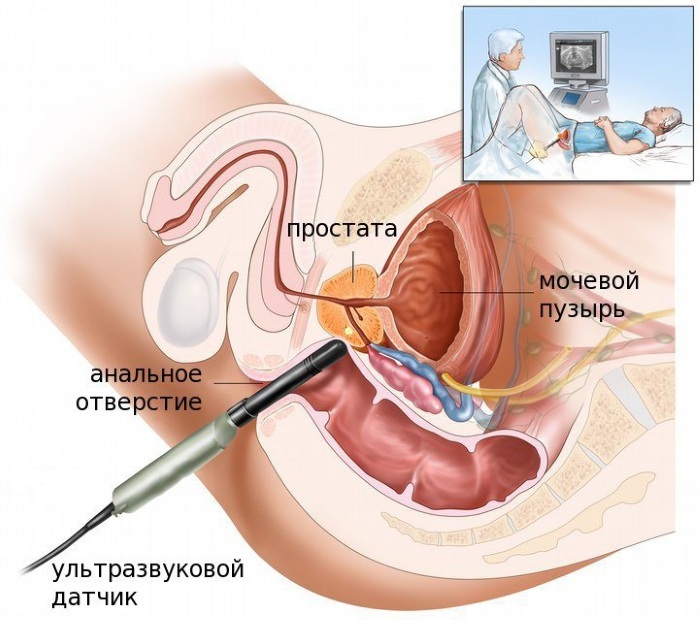
The procedure goes as follows:
- The man completely removes all his clothes below the waist (sometimes he is given a special medical shirt) and lies down on the couch on the right or left side with your back to the doctor and the device (depending on which side the doctor).
- The patient then pulls the legs up to the chest, assuming the fetal position, as this is best suited for rectal procedures. In some cases, the patient must lie on his back.
- The ultrasound doctor puts a disposable condom on the sensor (he should remove it only in the presence of the patient), lubricate a man's anus with a special preparation that improves sliding and thus prevents injury and damage to the straight intestines.
- Then the doctor carefully inserts the probe into the anus to a depth of 5-7 cm, and, turning it, examines the prostate gland and nearby tissues.
- The doctor evaluates the parameters of the organ and records the information received.
- Then the probe is slowly removed from the anus, and the patient can get dressed.
The whole procedure takes no more than 30 minutes. If the patient behaves calmly, does not make sudden movements and is as relaxed as possible, then everything is painless and safe. During the examination, the anus should not be squeezed so as not to complicate the diagnosis. Breathing should be calm and even, without delay.
If pain is felt during the procedure, then it is imperative to tell the doctor about it - in this case TRUS is immediately discontinued and a routine ultrasound scan through the abdomen or other is used for diagnosis. ways.
If anxiety and nervousness are felt, then before the procedure, in agreement with the doctor, you can take a sedative.
What does the doctor see during the study?
During the examination, the soft tissues of the body reflect the ultrasonic waves emitted by the transducer and are formed into an image. It is displayed on the screen and the doctor can judge the health of the prostate gland.
The prostate capsule is clearly visible on the screen - the continuity of its contours and symmetry indicate the normal functioning of the organ. If any part of the prostate gland has increased echogenicity, then this may indicate the formation of fibrosis or the presence of inflammatory processes.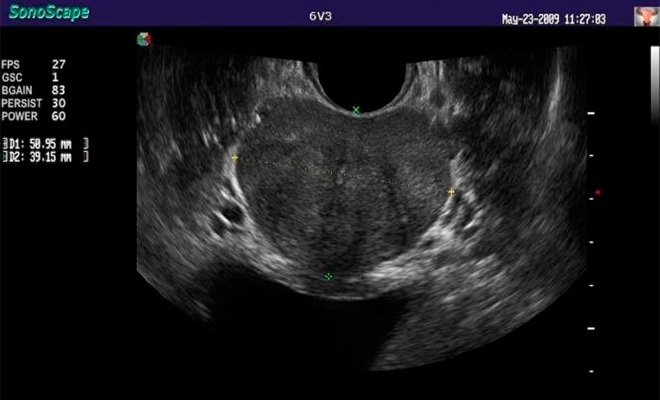
Also, in the process of diagnosis, the doctor pays attention to the following details:
- the volume of the prostate (in men of different ages, the volume of the prostate is slightly different);
- the state of blood vessels and the level of blood supply to the prostate;
- visual condition of the seminal vesicles.
Usually the first half of the examination is done with a full bladder, then the doctor sends the patient to the toilet to empty the organ. Then the specialist re-conducts TRUS in order to assess the level of bladder emptying (signs of "residual urine").
Feelings of the patient
The TRUS procedure is painless, and therefore a patient who does not have rectal pathologies should not feel pain. If painful sensations are present, then the man must definitely tell the doctor about it, so how they can indicate the presence of cracks in the anus and rectum, hemorrhoids and others diseases.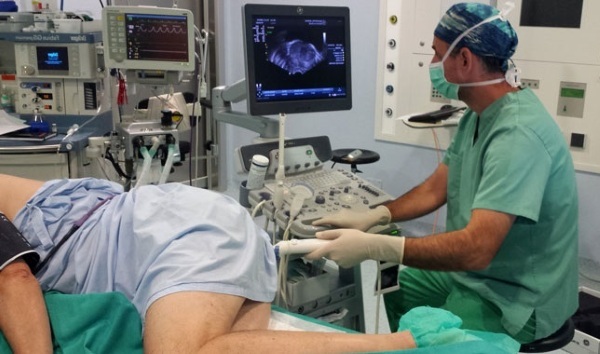
Also, men may experience slight discomfort during the diagnosis - this is a normal sensation arising from the presence of a foreign body in the rectum.
If after the procedure the patient bleeds from the anus, then most likely the mucous membranes were damaged rectum or internal hemorrhoids that the man might not have known about (especially if they have small the size). In this case, you urgently need to consult a proctologist who is engaged in the diagnosis and treatment of rectal pathologies.
Decoding the results
A normally functioning prostate gland is a completely symmetrical organ with smooth contours. The shape can be different: triangular, round or oval. The structure of the prostate should be homogeneous, and the echogenicity should be the same in all parts of the organ.
Changes in echogenicity may indicate the following diseases:
- reduced echogenicity - acute prostatitis;
- increased echogenicity - chronic prostatitis;
- hypoechoicity (too low) - the presence of cysts and stones in the tissues of the prostate.
Abnormalities in the size of the prostate and associated organs may indicate pathology.

The normal sizes of the prostate are as follows:
| Length | 25-40 mm |
| Width | 28-45 mm |
| Thickness | 15-25 mm |
| The size of the seed tubercle | 2-3 mm |
| Seed tubercle shape | Triangular |
The volume of the prostate is calculated according to a special formula - it should not be more than 200-280 mm. cub.
The remainder of urine in the bladder should not exceed 15 ml. If the value exceeds the norm, then this indicates the presence of inflammatory diseases of the genitourinary system, as well as obstruction or stricture of the urethra.
What diseases can be diagnosed using the method?
With the help of transrectal ultrasound, the doctor can detect the following pathologies:
- Inflammation of the prostate - prostatitis. It can be acute (characterized by organ enlargement) and chronic (characterized by impaired blood supply to certain parts of the gland).
- Adenoma or prostate cancer - with these neoplasms, the contours of the prostate are uneven (usually enlarged on one side), the structure of the tissues is heterogeneous, and the neoplasms themselves have asymmetric boundaries.
- Cysts and calculi - are manifested by low echogenicity of the affected areas of the prostate gland.
- Hyperplasia of the prostate - is an overgrowth of the glandular tissue of an organ, which may indicate inflammation or cancerous tumors.
-
Vesiculitis - an inflammatory disease of the seminal vesicles.

The listed pathologies can be the cause of male infertility, decreased erectile function and libido. In some cases, TRUS alone is not enough, therefore, for an accurate diagnosis, the doctor may prescribe additional tests and examinations.
TRUS is superior to conventional ultrasound in terms of information content and accuracy. But you need to prepare for the study comprehensively so that the diagnostic results are not distorted, and the doctor does not make an incorrect diagnosis.
Video about TRUS
Doctor about ultrasound of the prostate:
